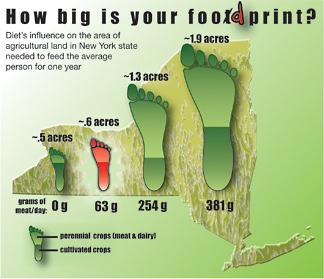
 1
1








The minimum amount of agricultural land necessary for sustainable food security, with a diversified diet similar to those of North America and Western Europe (hence including meat), is 0.5 of a hectare per person. This does not allow for any land degradation such as soil erosion, and it assumes adequate water supplies. Very few populous countries have more than an average of 0.25 of a hectare. It is realistic to suppose that the absolute minimum of arable land to support one person is a mere 0.07 of a hectare–and this assumes a largely vegetarian diet, no land degradation or water shortages, virtually no post-harvest waste, and farmers who know precisely when and how to plant, fertilize, irrigate, etc. [FAO, 1993]
Seed the Mind, Harvest Ideas.
http://farmwhisperer.com









Sustainable Plantations and Agroforestry in Costa Rica








Our Microgreens: http://www.microortaggi.it








find religion! church
kiva! hyvä! iloinen! pikkumaatila
get stung! beehives
be hospitable! host-a-hive
be antisocial! facespace
 1
1




Idle dreamer








William James wrote:I think it's also important to think outside the box on this one. If your mind is trained to think with the <people = food = land> equation, then you probably won't be able to get very far.
A much better equation is:
<People = Other People> and "other people" implies that something is going to be coming your way from outside your <food = land> system. So, it's just a matter of how well you are able to build and nurture the connections that allow a small amount of land to produce the "seed money" to kickstart this other equation.




My books, movies, videos, podcasts, events ... the big collection of paul wheaton stuff!
 1
1




"When there is no life in the soil it is just dirt."
"MagicDave"













Monte Hines-Hines Farm Blog- http://hines.blogspot.com




 2
2








garrett lacey wrote:My one question is the caloric intake that they based this off of.. is it the standard sort of FDA thing or is it pared down somewhat? Ive read a few articles indicating calorie restricted diets lead to longer lifespan in test animals.
"When there is no life in the soil it is just dirt."
"MagicDave"
 2
2





Lisa Allen MH (AstroHerbalist)
TimingMagic.com
 1
1








I agree Garrett.garrett lacey wrote:Right. I just did some more light reading on calories and as far as i can tell, i consume a fair bit less than the recommended caloric intake of someone of my size. I am pretty active (physical jobs, walking/biking everywhere) and i am not losing weight.
However, i really dont enjoy thinking of my food in terms of calories. I'll just keep trying to maximize the productivity of my spaces, and eat what feels right i suppose.
"When there is no life in the soil it is just dirt."
"MagicDave"








Brenda
Bloom where you are planted.
http://restfultrailsfoodforestgarden.blogspot.com/




 There are many other ornamental edibles which can if needed form the staple component of the diet, producing tubers or bulbs.
There are many other ornamental edibles which can if needed form the staple component of the diet, producing tubers or bulbs. 
Idle dreamer
 3
3




Projects, plans, resources - now on the Permies.com digital marketplace.
Try the Everything Combo as a reference guide.




"When there is no life in the soil it is just dirt."
"MagicDave"








Idle dreamer








Alison Freeth-Thomas wrote:Someone shared this link last week and I was amazed at how much these guys grow on 1/10 acre - 6000lbs of produce and IIRC 350 different fruit/veg varieties.
http://urbanhomestead.org/
The Facts and Stats page is inspirational.













Idle dreamer








Monte Hines wrote:I found the research work of Chris Peters very interesting and informative on the subject. Chris Peters, the lead author of the study on New York's agricultural footprint, has been honored for related work on local "foodsheds," as well as his teaching and outreach, with the 2007 Gerald O. Mott Scholarship for Meritorious Graduate Students in Crop Science.
Anyone who believes exponential growth can go on forever in a finite world is either a madman or an economist.




Mike H wrote:
1.67 additional acres is enough to graze and produce winter fodder???
Idle dreamer




Monte Hines-Hines Farm Blog- http://hines.blogspot.com
 2
2




Graze and produce winter fodder for what, where? It takes 20 - 50 acres to graze one steer in my region.
 1
1




Walter Jeffries wrote:
This points out how important it is to consider the location.
Idle dreamer

|
Chop wood, carry water. Find enlightenment. Chop wood, carry water, and read tiny ads.
Permaculture Pond Masterclass with Ben Falk
https://permies.com/t/276849/Permaculture-Pond-Masterclass-Ben-Falk
|




